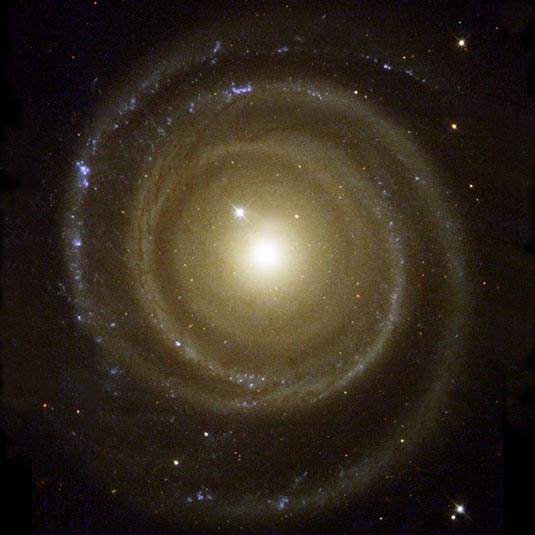
Face-on Spiral Galaxy
R.A. 12h 42m 37.7s Dec. -40° 44' 35"
Centaurus
About 34 million parsecs (111 million light-years)
13
1.7 x 1.6 arcmin
The image is roughly 1.6 arcminutes (16 kiloparsecs) across.
May 25, 2001
1.7 hours
NASA & The Hubble Heritage Team (STScI/AURA) Ack: Dr. Ron Buta (U. Alabama), Dr. Gene Byrd (U. Alabama) & Tarsh Freeman (Bevill State Community College)
February 7, 2002
ABOUT THIS IMAGE:
Astronomers have found a spiral galaxy that may be spinning to the beat of a different cosmic drummer.
To the surprise of astronomers, the galaxy, called NGC 4622, appears to be rotating in the opposite direction to what they expected. Pictures by NASA's Hubble Space Telescope helped astronomers determine that the galaxy may be spinning clockwise by showing which side of the galaxy is closer to Earth. A Hubble telescope photo of the oddball galaxy is this month's Hubble Heritage offering. The image shows NGC 4622 and its outer pair of winding arms full of new stars [shown in blue].
Astronomers are puzzled by the clockwise rotation because of the direction the outer spiral arms are pointing. Most spiral galaxies have arms of gas and stars that trail behind as they turn. But this galaxy has two "leading" outer arms that point toward the direction of the galaxy's clockwise rotation. To add to the conundrum, NGC 4622 also has a "trailing" inner arm that is wrapped around the galaxy in the opposite direction it is rotating. Based on galaxy simulations, a team of astronomers had expected that the galaxy was turning counterclockwise.
NGC 4622 is a rare example of a spiral galaxy with arms pointing in opposite directions. What caused this galaxy to behave differently from most galaxies? Astronomers suspect that NGC 4622 interacted with another galaxy. Its two outer arms are lopsided, meaning that something disturbed it. The new Hubble image suggests that NGC 4622 consumed a small companion galaxy. The galaxy's core provides new evidence for a merger between NGC 4622 and a smaller galaxy. This information could be the key to understanding the unusual leading arms.
Galaxies, which consist of stars, gas, and dust, rotate very slowly. Our Sun, one of many stars in our Milky Way Galaxy, completes a circuit around the Milky Way every 250 million years.
NGC
4622 resides 111 million light-years away in the constellation Centaurus.
The pictures were taken in May 2001 with Hubble's Wide Field Planetary
Camera 2.